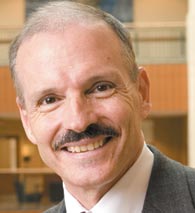|
Executive Interviews: Interview with Roland T Rust on Co-Creation
March 2010
-
By Dr. Nagendra V Chowdary
 Roland T Rust
Roland T Rust Distinguished University Professor and David Bruce Smith Chair in Marketing at the Robert H Smith School of Business at the University of Maryland, 
Professor, congratulations for
being an accomplished academician
in the field of marketing research; for
being the founder and Executive
Director of two research centers at
Robert H Smith school of business;
and other scholastic achievements.
How has the discipline of marketing
research changed over the last
decade? Has it become highly
sophisticated, with books like
Buyology, bringing in the
perspectives of neuroscience?
Marketing research has becomemuch
more focused on individual
customers, because of available data.
Where companies used to focus on
brand value, now they focus on
customer lifetime value. Instead of
brand equity, the key concept is
customer equity. Related to this,
customer relationships, rather than
transactions, are the focus. The key
driving force behind all of this is
information and communication
technologies, which have advanced
tremendously. You mention
neuroscience. The application of
neuroscience to marketing has
advanced very quickly, because of
new brain imaging technologies.
Why is it that we still see many
blockbuster products getting
bombed? For instance Apple’s
iPhone in India didn’t meet with the
anticipated success. Was it the failure
to read the consumers’ correctly or
was it due to overconfidence?
Why is it that we still see many
blockbuster products getting
bombed? For instance Apple’s
iPhone in India didn’t meet with the
anticipated success. Was it the failure
to read the consumers’ correctly or
was it due to overconfidence?
Why is it that we still see many
blockbuster products getting
bombed? For instance Apple’s
iPhone in India didn’t meet with the
anticipated success. Was it the failure
to read the consumers’ correctly or
was it due to overconfidence?
Why is it that we still see many
blockbuster products getting
bombed? For instance Apple’s
iPhone in India didn’t meet with the
anticipated success. Was it the failure
to read the consumers’ correctly or
was it due to overconfidence? links, which facilitate interaction. We
see the same thing happening with
collaborative research in business
schools. For example, one paper of
mine that I recently published needed
some special expertise. So I contacted
a professor in Belgium, who became a
co-author on the paper. With the
Internet, it did not matter at all that
my co-authorwas fromBelgium. That
wouldn’t have been true 15 years ago.
What according to you is the
difference between traditional system
of value creation and co-creation as
propounded by you? Can you give us
few examples of those companies that
have benefited from co-creating
value?
Value creation is static. The idea is to
build a product, which may be either
a physical good or a service, such that
customers will find value in it. This
typically involves marketing research
on the front-end and mass selling on
the back end. Co-creation is dynamic,
rather than static. The idea is that give
and take with the customer will be
the service. For example, in the US
there is a store called ‘Build-a-Bear.’ In
that store children help assemble a
personalized bear, making all sorts of
decisions about the bear – the bear’s
name, clothes, etc. This creates a
much closer bond with the customer
than just building a bear based on
average consumer preferences and
selling the same bear to everyone.
How did the relationship between
the customer and the company
change over decades and what did
this change mean for business
practices?
How did the relationship between
the customer and the company
change over decades and what did
this change mean for business
practices?
What specific trends do you think are warranting the companies to look
beyond the traditional value creation
and embrace co-creation as the new
competitive platform?
It’s a competitive necessity.
Embracing the relational co-creation
viewpoint enables far more
personalized service. Again, it is
information and communications
technology that is driving this.
|
